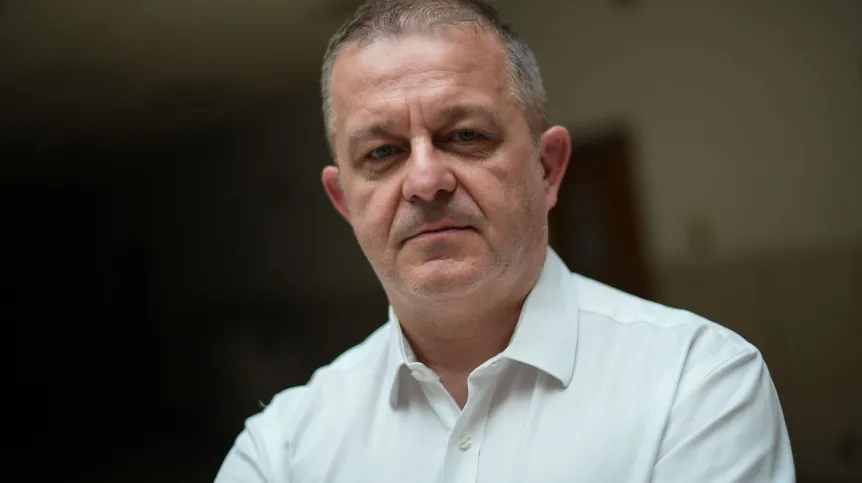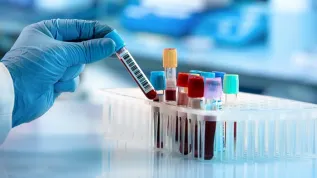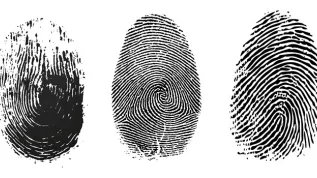
This fluid can replace blood, it can supply oxygen to tissues and remove carbon dioxide from them. We are dealing with a breakthrough when it comes to the future of medicine, says Professor Wojciech Lisik from the Department of General and Transplantation Surgery of the University Clinical Centre of the Medical University of Warsaw.
PAP: Professor, if I understood the importance of this invention correctly, we have a Copernican breakthrough in medicine: Polish scientists have invented a fluid that can replace blood.
Professor Wojciech Lisik: It can replace blood, but for now only in the area of gas exchange - it can supply oxygen to tissues and remove carbon dioxide from them. So we are dealing with a breakthrough when it comes to the future of medicine.
PAP: Has no one in the world done this yet?
W.L.: We do have competition, because many research centres are trying to come up with something like this. But we already have it, and on top of that it is a Polish patent. For now, the research process is underway to get to the point when this invention can be used in practice to save lives. The certification process requires proof that the fluid is good, non-toxic and effective in the areas in which we want to implement it.
PAP: What can it be used for in the future?
W.L.: We want it to be capable of replacing blood in the transport of oxygen and removal of carbon dioxide from tissues. Today, blood cannot be replaced by anything except other blood from donors, because it contains erythrocytes - the only natural cells that carry oxygen and receive CO2. If they are not there, a person dies from lack of oxygen. However, the fluid we are talking about contains particles that can replace red blood cells.
PAP: I understand, but, in addition to oxygen, blood also transports nutrients.
W.L.: That is true, but in the case of this fluid, the key issue is to save someone's life - for example, in the event of a sudden, massive haemorrhage, a few, a dozen minutes are important and these nutrients do not have much significance then. However, if there is more time, you can add the ingredients you are talking about to this fluid, you can add drugs, growth factors, all these products that will additionally nourish the cells and appropriately stimulate them. But the crux of this patent are these particles that can carry oxygen.
PAP: You already know that this fluid transports oxygen, because you have tested it experimentally.
W.L.: The idea for proving that this fluid works is very simple. We took a kidney from a pig, connected it to our own perfusion device NanOX Recovery Box, which allowed us to flush the organ with a fluid containing nanoparticles that supplied the organ with oxygen and removed carbon dioxide, which was necessary for cells to maintain oxygen metabolism. The vital functions of the organ, as well as its suitability for implantation, were constantly monitored by the perfusion device.
It should be emphasized that in the system we use, this is done to a much wider extent than in the case of similar devices available on the market, thanks to the use of a complex data analysis model. After a dozen or so hours, we took a sample of the organ and checked whether its cells were alive. However, it was still necessary to check whether the kidney had retained its functions. To that end, after removing the second kidney, we implanted a kidney previously perfused with our fluid into the same animal. It turned out that the 'patient' functioned well with one kidney, which had been outside his body for a long time - it felt good, urinated, and normalised biochemical parameters.
Importantly, in this method, the organ does not have to be stored at a low temperature. Today, most organs taken from a donor are stored in a state of hypothermia, at a temperature of approximately 4 degrees Celsius, which slows down cellular metabolism, reduces oxygen consumption to almost 5 percent of the initial value and ultimately does not allow for regeneration. NanOX perfusion takes place in subnormothermia (approx. 25 degrees Celsius) and normothermia (37 degrees Celsius). Such storage conditions maintain cellular metabolism, and thanks to this we can obtain conditions for 'treating' organs during storage. We already know that livers kept in such a system are able to reduce their steatosis, which means that if we have a diseased organ that is not fully acceptable for transplantation, we can make it healthy enough to be used in transplantology.
Imagine a different situation: the patient has a tumor in their only kidney, so we remove it, pass our fluid through it, to which chemotherapeutics have been added in a concentration that would normally be unattainable in diseased tissue, and at the same time certainly toxic to the patient. We treat the kidney and after a few days we 'give it back' to our patient. I'll go even further: someone dies from a serious accident, but their brain remains undamaged. We take it, perfuse it...
PAP: And then you have to find a body donor. It's a terrifying vision.
W.L.: On the one hand it is, but once people thought it was terrifying that you could cut a person open and then sew them up. The vision of the possibility of transplanting a heart into someone was terrifying, and today it's a daily life-saving thing. We transplant limbs, internal organs, bone marrow, virtually all organs except the brain.
PAP: I prefer not to imagine the loneliness of a brain deprived of all senses.
W.L.: You are right, this may be a serious dilemma – we will leave it to our successors. After all, we know that the senses are for the brain, not the brain for the senses. We eat to feed our brain, not to nourish the hand. The brain is the central point. The receptors are not there so that we can derive pleasure from sex, for example, but because the brain has a mission to extend its genetic line. Pleasure is only a reward. We seek new experiences because our brain is curious, wants to develop and position itself better among the competition.
A person is what is in their head. When brain death occurs, i.e. the death of the brain stem, its oldest part (not to be confused with coma), a person dies. We can maintain the vital functions of the organs in the body of the deceased as a result of brain death for some time, ventilate the lungs, but despite this, a metabolic storm breaks out and after some time the organs stop working. So it's not like you can 'culture' a brain-dead person forever, because the brain is what connects the functions of all our organs.
PAP: What is the substance that carries oxygen in your miraculous fluid?
W.L.: The NanOX 4K nanoparticle, which is the heart of the perfusion fluid and the basic component of the entire NanOX system. Its inventors are employees of the Department of Biotechnology and Bioprocess Engineering at the Warsaw University of Technology, headed by Professor Tomasz Ciach.
And getting back to our 'artificial blood' - I hope that it will soon turn out that blood donors are unnecessary, and instead of an ambulance with blood, the President of the United States will be followed by a bottle of water and a can of powder, from which an oxygen-carrying fluid can be quickly prepared, and people will no longer die in wars due to massive blood loss.
PAP: Tell us at what stage of the research you are and what will happen in the near future.
W.L.: For now, we are still testing the functionality of the organs subjected to perfusion – to put it simply, we check how much the animal pees, we test the blood and urine to assess how the parameters of kidney failure are decreasing. The next step will be to study how the fluid is metabolised in the body – whether it remains in the serum or is secreted from the body.
I hope that we will also conduct experiments using the liver and check how much of it we can safely store and how effectively we can improve its quality before transplantation.
The research also includes assessing whether this fluid does not immunise, i.e. does not cause the formation of antibodies, which is important in the case of people who have had blood transfusions several times - they quite often develop antibodies that fight other people's cells, which is why we have a problem with selecting an organ for a person who has been on dialysis for a long time and required blood transfusions from time to time.
PAP: How many years could it take?
W.L.: That depends. We have excellent scientists, but insufficient funds. The COVID vaccine was invented in a matter of months, although work on the vaccine against the C virus has been going on for over thirty years. Implementing the research area of other viruses in SARS-CoV-2 research and injecting gigantic resources gave such a fantastic effect.
Interview by Mira Suchodolska (PAP)
mir/ mhr/ kap/
tr. RL













